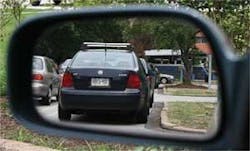Just as a flat mirror is a nonimaging optic, so are most free-form reflectors. And, just as a flat mirror can be a very important visual aid, so can a properly designed free-form reflector. R. Andrew Hicks, a researcher at Drexel University (Philadelphia, PA), has proved this to be true by developing an automobile rear-view mirror that has a field of view more than twice as wide as that of a conventional flat rear-view mirror; and, unlike the spherical mirrors that are sometimes used in attempts to eliminate blind spots, the mirror designed by Hicks introduces almost no distortion to the field of view (see figure).1
A flat rear-view mirror normally has a field of view somewhere around 15° to 20°. The mathematical transformation that the free-form equivalent must perform is a simple scaling (with the assumption that the angle between the reflector’s central incoming and outgoing rays is 65°). Hicks determined that if the scaling constant is too high, distortion is unavoidable, but for a field of view of up to 45° the amount of distortion is minimal.
Not a simple surface
The shape of the resulting surface is hard to describe, notes Hicks. “It’s generated by solving some differential equations numerically, which give a collection of points on the surface,” he says. “I then fit a polynomial to this, which is generally of high degree. So I can’t say that it is like some familiar surface.” The prototype reflector was fabricated on a Moore Nanotech 500FG Freeform Generator (B-Con Engineering; Nepean, Ontario, Canada).
Hicks is working to extend his calculations beyond the single-ray-bundle assumption, and is also now working on the use of free-form design for illumination systems. “My general area of research is to find efficient methods for optical design (especially free-form surfaces) by applying methods from differential geometry,” he says.
REFERENCES
- R. Andrew Hicks, Optics Lett. 33(15) 1672 (Aug. 1, 2008).
- R. Hicks, J. Opt. Soc. Am. A 22, 323 (2005).

John Wallace | Senior Technical Editor (1998-2022)
John Wallace was with Laser Focus World for nearly 25 years, retiring in late June 2022. He obtained a bachelor's degree in mechanical engineering and physics at Rutgers University and a master's in optical engineering at the University of Rochester. Before becoming an editor, John worked as an engineer at RCA, Exxon, Eastman Kodak, and GCA Corporation.
